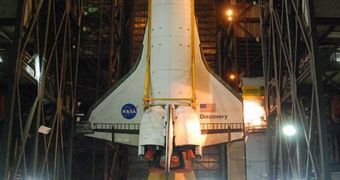Officials at NASA announce that engineers at the Kennedy Space Center (KSC) have affixed the space shuttle Discovery to its external fuel tank and twin solid rocket boosters (SRB).
The maneuver was performed in anticipation of the orbiter's launch to the International Space Station (ISS), where it is due to deliver critical spare parts and other components.
This will be the last flight that Discovery is scheduled to take, and so everyone at the KSC was extremely touched by the new event, which took place in the cavernous Vehicle Assembly Building.
The VAB is where the mobile platform called the Crawler Transporter reside. On top of it, engineering teams place the external fuel tanks that the shuttle uses, as well as the twin SRB, which provide extra lift during take-off.
The shuttle is then brought out of the Orbiter Processing Facility (OPF), and undergoes a rollout to the VAB, where impressive cranes pick it up and set it in its flight configuration.
Discovery was taken out of its hangar on September 9, and NASA officials currently plan to have it roll out to its launch pad on Monday, September 20.
Before the shuttle was affixed to its 15-story fuel tank, an attachment nut became loose, and then fell into Discovery's aft compartment. After setting up access gantries, KSC engineers were able to retrieve the object, which did not cause any damage.
According to the American space agency, Discovery will begin rolling out Monday at around 8 pm EDT (0000 September 21 GMT), with the entire maneuver expected to last six to seven hours.
“We're allowing a number of employees to bring their families out to see the rollout. I expect we'll see several hundred,” says for Space Candrea Thomas, who is a spokeswoman for the agency.
At this time, the shuttle is scheduled to launch no early than November 1, on mission STS-133. This will represent its 39 spaceflight, experts say.
The spacecraft will spend about 11 days affixed to th eorbital laboratory, during which time six astronauts will deliver a new Pressurized Multipurpose Module and the third ExPRESS Logistics Carrier to the station.
In addition to that, Discovery will also deliver the Robonaut-2 machine, a robot designed by NASA and General Motors to assist astronauts in orbit in performing current tasks.
The shuttle will return to Earth before the ISS enters an unfavorable configuration later on in the year, when its orientation from the Sun will not allow it to support a docking spacecraft.

 14 DAY TRIAL //
14 DAY TRIAL //